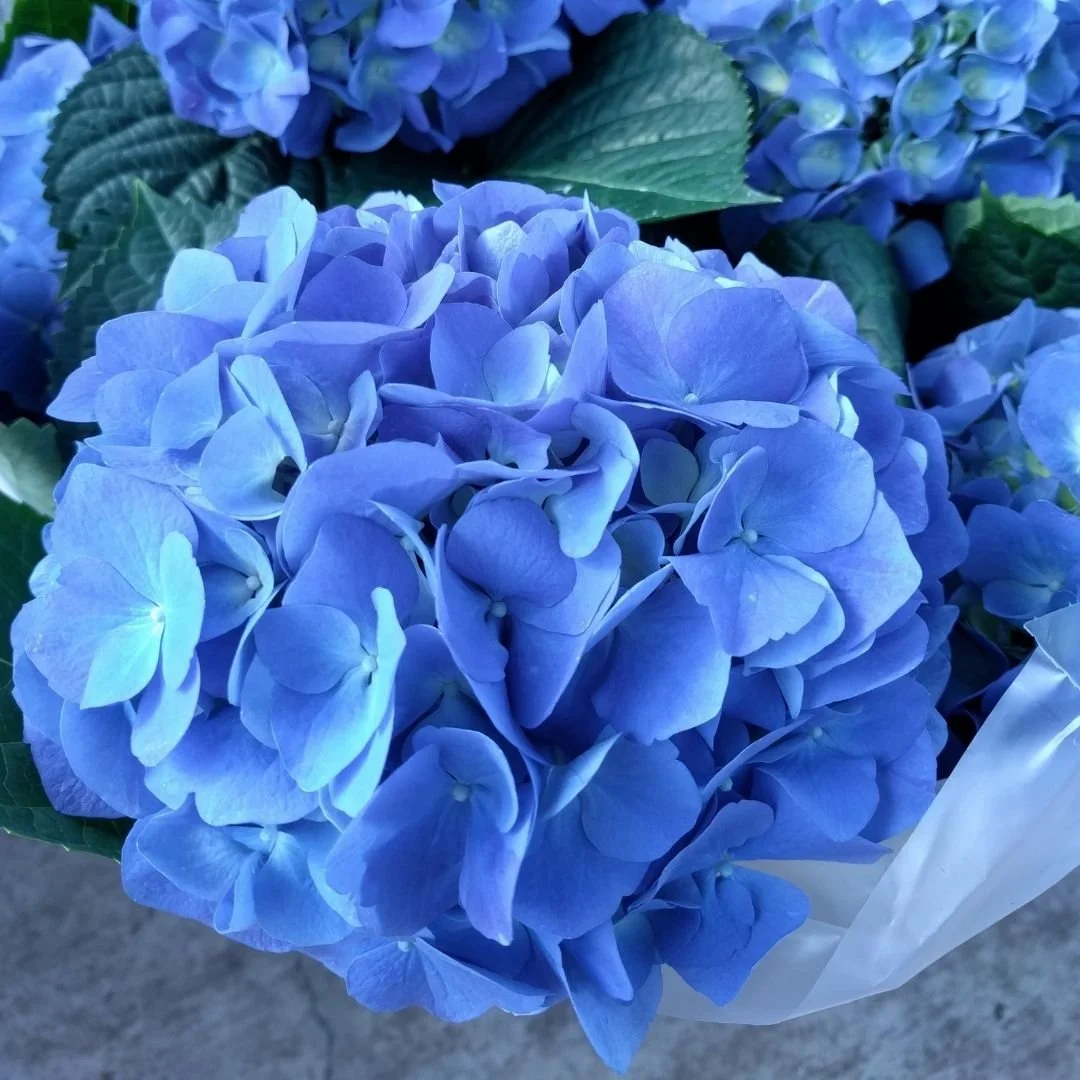Mathilda Gutges Bigleaf Hydrangea
Multicolored Mophead Flowers
The flowers of this bigleaf hydrangea turn blue, pink, purple and mauve - all on the same plant!
The Mathilda Gutges hydrangea (Hydrangea macrophylla ‘Mathilda Gutges’) is a cultivar of the bigleaf hydrangea, a deciduous shrub native to Japan and China belonging to the Hydrangeaceae family.
This old-fashioned selection, bred in 1940s Germany, flowers heavily all summer long with mophead flowers in shades of blue, pink, purple and mauve.
Flowers can sport all four shades on the same plant, or bloom in uniform shades of bright blue or vivid pink, depending on the soil pH.
The flower color of the Mathilda Gutges hydrangea is influenced by the soil pH. Image courtesy of Ball Horticultural Company.
This compact plant is a great choice for containers, pots and planters, reaching a mature size of 3-4 feet tall and wide.
It can also be planted in-ground, directly into the garden, but may suffer from dieback and frost damage from weather extremes, resulting in reduced flowering.
Mathilda Gutges hydrangeas grow in zones 6 - 9, and prefer partial shade and rich, well-draining soil.
Partial shade is important, as these hydrangeas can be sensitive to intense sun exposure, particularly in the afternoon.
In extreme heat the large leaves of bigleaf hydrangeas lose water quickly through transpiration, leading to wilting.
Deer will eat hydrangea flower buds and leaves, especially the tender young growth.
If you would like to grow a flowering shrub that deer tend to leave alone, try Ruby Spice summersweet clethra as a deer resistant alternative to the bigleaf hydrangea.
Does the Mathilda Gutges Bigleaf Hydrangea Bloom on Old or New Wood?
The Mathilda Gutges hydrangea blooms on old wood. Flower buds for the summer season have developed on the previous year's growth.
This shrub has a compact shape and generally does not need pruning, but if you must prune your Mathilda Gutges hydrangea, it should be done after it has finished blooming for the year and before the next season's buds begin to form.
Pruning too late can risk removing the buds, potentially affecting the plant's blooming performance for the following season.
To put this in context of the seasonal gardening calendar:
Spring - buds have been set the previous year, so don’t prune! However, you may remove and clean out old, dead, or weak stems. You can tell which stems are dead by scratching away at the surface of each stem. If you see green, it’s a living stem and you should be left alone. If you see brown, the stem is dead and can be safely pruned away.
Summer - the shrub is flowering, enjoy the show! When flowering has finished, you have a small window of time to prune the shrub, if needed, before late summer. Flower buds develop starting in late summer to early fall. Complete your pruning prior to late summer.
Fall - buds are forming for next spring’s flowering show - don’t prune! You do not need to prune back Mathilda Gutges hydrangeas in the fall.
Winter - buds are set for the springtime - don’t prune!
Frost Damage and the Mathilda Gutges Hydrangea
Mathilda Gutges hydrangea buds, like those of many bigleaf hydrangea varieties, can be susceptible to damage from extreme weather conditions. Frost damage to a hydrangea ranges from minor to severe, and can look like shriveled brown or black leaves and buds and drooping, wilting flower heads.
Late Spring Frosts: Mathilda Gutges hydrangea buds are formed on old wood, and if a late spring frost occurs after the buds have emerged it can damage or kill the flower buds, leading to reduced or no flowering for the rest of the summer.
Freezing Temperatures: Extremely low temperatures, especially in winter or early spring, can also damage the buds. Prolonged exposure to freezing temperatures can cause the buds to freeze and become more susceptible to damage.
Unseasonal Temperature Fluctuations: Drastic fluctuations in temperatures during the bud development stage can be harmful. Warm periods followed by sudden cold snaps can disrupt the normal development of buds, potentially leading to bud damage.
In regions where late spring frosts are common, like the Northern and Mid-Atlantic states, Mathilda Gutges hydrangeas are more susceptible to frost damage, resulting in reduced or no flowering for an entire season.
If you are worried about this potential for frost damage, consider growing a reblooming hydrangea cultivar like the Endless Summer® Pop Star® Reblooming Hydrangea.
How to Plant and Grow the Mathilda Gutges Bigleaf Hydrangea
Planting: The best time of year to plant a hydrangea is in the spring or fall, giving the roots time to establish before the onset of extreme hot or cold weather. Water deeply immediately after planting.
Location: Choose a location with well-drained soil that is rich in organic matter. Mathilda Gutges hydrangeas prefer soil that retains moisture but does not become waterlogged. Select a spot with partial shade and protection from the intense afternoon sun.
Soil: Amend the soil with organic matter, such as compost, shredded leaves, or Leaf-gro® to improve drainage and soil fertility. If you would like your Mathilda Gutges hydrangea to bloom a more pink, consider getting a soil test and adding lime to the soil. Add sulfur for bright blue flower coloration.
Mulch: Apply a layer of organic mulch around the base of the plant to retain soil moisture, regulate temperature, and suppress weeds. Make sure the mulch does not touch the base of the plant.
Watering: Keep the soil consistently moist but not waterlogged, especially during periods of drought. Deep watering is preferable to encourage the development of a strong root system (Are you in a drought? Check the U.S. Drought Monitor).
Fertilization: Hydrangeas typically do not need fertilization when they are given the rich, fertile soil they prefer. Each spring, spread a layer of compost, shredded leaves or Leaf-gro® around the base of your hydrangea, being careful to keep away from the base of the shrub.
Pruning: Mathilda Gutges hydrangeas grow buds in late summer and fall on old wood - consequently, pruning should be done in early to mid-summer, immediately after flowering. No more than 1/3 of the plant should be cut back.
Problems, Pests and Diseases: Bigleaf hydrangeas are prone to damage from late spring frosts - leaves and buds can appear scorched, black and burnt. Fungal diseases such as powdery mildew, cercospora leaf spot and anthracnose can also affect hydrangeas. Cottony camellia scale is an occasional pest problem. Ensure good air circulation around your plants to minimize the risk of disease, and practice good watering habits (see “How to Water your Plants” to brush up on your watering skills).
Do Mathilda Gutges Bigleaf Hydrangeas Like Sun or Shade?
Mathilda Gutges hydrangeas thrive in partial shade (2-4 hours of direct sunlight per day).
While they can tolerate more sun, these hydrangeas prefer dappled or filtered light, with protection from the intense hot afternoon sun.
In hot climates, providing them with morning sun and afternoon shade can help prevent their flowers and leaves from wilting and scorching.
In cooler regions, they may tolerate more sun, but protection from harsh afternoon sunlight is still recommended.
How to Change the Color of a Mathilda Gutges Bigleaf Hydrangea
You can change the color of your bigleaf hydrangea blooms by manipulating the pH of the soil.
The pH level affects the availability of aluminum in the soil, in turn influencing the color of hydrangea flowers.
Adding aluminum sulfate, garden sulfur, or organic matter makes the soil more acidic and will turn Mathilda Gutges hydrangea flowers a bright blue.
Adding garden lime raises the soil pH and turns the flowers a vibrant pink shade. Be patient - it can take months for change to become evident!
Are Mathilda Gutges Bigleaf Hydrangeas Poisonous to Dogs?
Mathilda Gutges bigleaf hydrangeas (Hydrangea macrophylla ‘Mathilda Gutges’) contain compounds that can be toxic to dogs if ingested, specifically cyanogenic glycosides.
These compounds can release cyanide when broken down in the digestive system.
However, the level of toxins in bigleaf hydrangeas are relatively low, and instances of dogs getting poisoned by consuming these plants are rare.
While the risk of severe poisoning is low, it’s important to monitor your dog's behavior in outdoor spaces.
If you suspect your dog has ingested a toxic plant, seek immediate veterinary care or contact the Pet Poison Hotline (read “Which Plants are Toxic to Dogs” for more information on plants poisonous to dogs).



